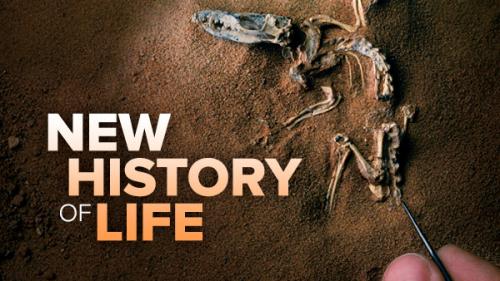TheGreatCoursesPlus - A New History of Life
Learn the history of life in a dramatic new way with this fascinating course that draws upon biology, earth science, and other disciplines to explain life's mysterious origins.
1: The Interconnected Earth
- Begin the story of life on Earth with an overview of the unifying idea that will govern your exploration. Called Earth system science, this approach views Earth as an integrated network comprising the lithosphere, hydrosphere, atmosphere, and biosphere. Sample the complex interactions between these realms.
2: The Vast Depths of Earth Time
- How was the great antiquity of Earth discovered? Survey the observations that led to the concept of deep time and, in the process, developed the tools that can read the story in rocks. End with a striking analogy that puts human time into perspective.
3: Fossil Clocks
- Delve into biostratigraphy, the study of fossil sequences in rock strata. The discovery that different layers of rock are characterized by distinctive fossils solved the problem of correlating sedimentary strata from different regions. This led to the geological time scale, initiating a revolution in Earth science.
4: Paleontologists as Detectives
- Learn how paleontologists interpret fossils to reconstruct the traits and environments of extinct life forms. Examine some of the pitfalls of the field, including cultural biases that can lead to doubtful conclusions, such as that Tyrannosaurus rex was as terrible as depicted in the movies.
5: The Shifting Surface of Planet Earth
- The history of science is marked by ideas that were before their time. One of the most important was Alfred Wegener's concept of continental drift, which was revived in the theory of plate tectonics. Explore the role that fossils played in this original grand unifying theory of geology.
6: Earliest Origins-Formation of the Planet
- Turn back the clock to Earth's earliest epoch, focusing on these questions: How did the solar system form and why do we live on a layered, differentiated planet? What do these events and the formation of the moon have to do with the evolution and development of life on Earth?
7: Origins of Land, Ocean, and Air
- Investigate the origin of Earth's ocean. Then track down the oldest rocks on the planet, which shed light on the first continents. Also explore the nature of Earth's primordial atmosphere and why we are surrounded by a thick blanket of air despite periodic blasts of charged particles from the sun.
8: The Early Chemical Evolution of Life
- Probe possible scenarios for the origin of life, from the "warm little pond" filled with organic compounds that Charles Darwin envisioned, to deep ocean environments energized by volcanic vents. Sharpen the search by defining the properties that the earliest life must have had.
9: Hints of the First Life Forms
- Did Martian meteorites seed the young Earth with simple life forms? Investigate this intriguing hypothesis. Then embark on a quest for Earth's oldest fossils, exploring their connection to organisms still found on the planet today, some of them hidden deep within the crust.
10: How Life Transformed the Early Earth
- Trace the perils of life on the early Earth. Having survived a seething period of volcanism and a withering bombardment by asteroids, bacteria-like organisms flourished and began to transform the planet. Learn how their success was almost their undoing.
11: Snowball Earth-Another Crisis
- Follow the clues that suggest Earth went through a snowball phase around 635 million years ago, nearly ending life's story. How did it happen? How was it reversed? And above all, how did photosynthetic life survive if it was trapped beneath the ice for millions of years?
12: Metazoans-Life Grows Up
- Make the transition to multicellular life, which grew in complexity as oxygen levels increased in the atmosphere, supporting creatures with more intricate metabolisms. This portion of the fossil record long eluded paleontologists, partly because few expected to find signs of life in ancient Precambrian rock.
13: Incredible Variety-The Cambrian Explosion
- The Cambrian period is notable for its immense variety of animals with many different body plans. In an explosion of diversification, shells, teeth, eyes, and other innovations emerged as creatures competed in an evolutionary arms race. Investigate the key factors driving this transformation.
14: Window to a Lost World-The Burgess Shale
- In 1909, paleontologist Charles Walcott chanced on one of the most remarkable fossil finds in history: the Burgess Shale in the Canadian Rockies. Tour some of this quarry's astonishing specimens, which brought the world of the Cambrian explosion to vivid life.
15: The Forgotten Fossils in Earth's Story
- Survey fossils that are often neglected in popular accounts of the history of life. Begin with corals and the reefs they build, which were teeming with invertebrates hundreds of millions of years ago. Then turn to micropaleontology, which is one of Professor Sutherland's research areas.
16: Introduction to the Great Mass Extinctions
- Earth's fossil record is punctuated with episodes when large fractions of all species abruptly disappeared. Examine the distinction between background extinction and mass extinction. Then look for factors that lead to these periodic catastrophes, and search beyond Earth for a possible explanation.
17: The Collapse of Earth's First Eden
- Five mass extinctions have occurred in the last 500 million years. Focus on the first of these, which extinguished the tropical paradise that flourished in the Ordovician period. Did plate tectonics initiate this radical transformation? Or could the cause have been extraterrestrial?
18: Making the Break for Land
- Consider the adaptations needed to make the transition from the buoyant, nourishing realm of water onto the perilous dry land, with its temperature extremes and relentless pull of gravity. Plants and animals each evolved unique adaptations to make this daring leap.
19: Getting a Backbone-The Story of Vertebrates
- Search for the earliest vertebrates, which arose from chordates-animals with a rod-shaped notochord. Also probe the mystery of an extinct chordate called the conodont, which is valuable in oil exploration. Finally, discover why we have calcium phosphate skeletons.
20: The Evolution of Jaws
- The first vertebrates were easy targets for killer arthropods and other marine predators. What eventually gave them the upper hand? Trace the circuitous evolution of jaws and the rapid development of fish that followed. Also crucial was the internal skeleton, which has some surprising advantages.
21: These Limbs Were Made for Walking?
- How did vertebrates make the leap from water to land? Follow the quest for evolutionary transitional forms for land-dwelling vertebrates, focusing on the competing theories of gradualism and punctuated equilibrium. The answer to the puzzle may lie in a transitional environment between water and land.
22: Tiktaalik-The Search for a Fishapod
- Hunt for the fishapod-the missing link between fish and four-limbed vertebrates, or tetrapods. Begin by investigating some "living fossils," including the celebrated Coelacanth. Then join the expedition led by paleontologist Neil Shubin that discovered Tiktaalik, a fossil fishapod that made worldwide headlines.
23: Carboniferous Giants and Coal
- Most of the world's coal deposits were laid down in the Carboniferous period, about 300 million years ago. Tour the global environment that created this unique formation and spawned many evolutionary innovations, including the amniotic egg. Also, discover why insects were much larger then than today.
24: Amniotes-The Shape of Things to Come
- Search for the origin of amniotes, which are egg-laying tetrapods, such as reptiles. Delve into the history of classification systems for life. The Linnaean system is based on resemblances between organisms. Learn why the more recent cladistic system, based on shared characteristics, implies that there is no such thing as a reptile.
25: Permian Extinction-Life's Worst Catastrophe
- Examine the full extent of the cataclysm that swept Earth 251 million years ago. Called the End-Permian extinction, the event left a chilling fossil record. Survey the clues that show land and ocean ecosystems collapsing, wiping out 95% of all plants and animal species.
26: Finding the Killer-The Greenhouse Earth
- Track down the smoking gun for the End-Permian extinction. Whatever was behind it plunged Earth into an intense greenhouse effect, turning the land into desert and throwing marine ecosystems into a death spiral. Probe a diverse range of theories before settling on the probable cause.
27: The Dinosaurs Take Over
- From the reptile populations that struggled through the End-Permian extinction, the dinosaurs ultimately emerged. What conditions promoted their evolution and eventual domination of the biosphere? And what other living things shared the planet with these paleontological celebrities?
28: Letting the Dinosaurs Speak-Paleobehavior
- How accurate are portrayals of dinosaurs in today's media? Learn what the fossil record says about how dinosaurs actually looked and lived. Also, probe the theory that dinosaurs were warm- rather than cold-blooded, which has important implications for their behavior.
29: Conquering the Air-The Evolution of Flight
- Take to the air to discover how creatures evolved the ability to fly. Insects made the leap first, aided by their small size. Feathered dinosaurs are thought to be the progenitors of birds. Unravel the avian link to dinosaur species such as Archaeopteryx and Microraptor.
30: Monsters of the Deep-Mesozoic Oceans
- Plunge into the oceans of the Mesozoic era, 251-65.5 million years ago, discovering that some creatures look familiar, while others are incredibly alien. The descendants of one monster of the Mesozoic, the plesiosaur, supposedly survive today in Scotland's Loch Ness. Weigh the evidence for and against these reports.
31: The Cretaceous Earth-A Tropical Planet
- Conditions in the mid- to late-Cretaceous were unusually tropical worldwide, with very high sea levels. As a test case in modeling ancient climates, study factors that may explain this remarkable episode in Earth's history. Also explore what it meant for life to exist in a global hothouse.
32: The Sky Is Falling-End of the Dinosaurs
- Study the most famous mass extinction of all: the disappearance of more than half of all species, including the dinosaurs, at the end of the Cretaceous period, 65.5 million years ago. Follow the clues that suggest an extraterrestrial impact caused a cascade of catastrophes.
33: The Collision of North and South America
- By the extinction of the dinosaurs, the continents were closing in on the configuration they have today-except North and South America had not yet joined. Tour the distinct flora and fauna of South America before its isolation ended with the land bridge to the north.
34: The Rise of Mammals and the Last Ice Age
- Mammals evolved at the same time as the dinosaurs but did not come into their own until well after their much larger competitors went extinct. Trace the rise of mammals and their domination through a series of glacial cycles, including the present interglacial period.
35: The Humble Origins of Human Beings
- Bearing in mind that humans are a transitional species, not the climax of creation, chart our humble origins and the source of our most distinctive feature: a large brain. Study the fossil record to learn which came first: a big brain or bipedal posture.
36: The Conscious Earth
- Close your exploration of the history of life on Earth by charting the evolution of consciousness. When did our progenitors first become self-aware, and what were the implications for the success of humans as a species? Finally, what are our prospects for spreading the biosphere beyond Earth itself?

A.New.History.of.Life.part1.GC.rar
A.New.History.of.Life.part2.GC.rar
A.New.History.of.Life.part3.GC.rar
A.New.History.of.Life.part4.GC.rar

































